Ferrovial Bundle
Who Really Owns Ferrovial?
Understanding the Ferrovial SWOT Analysis is crucial, but have you ever wondered about the power players behind this global infrastructure giant? Unraveling the
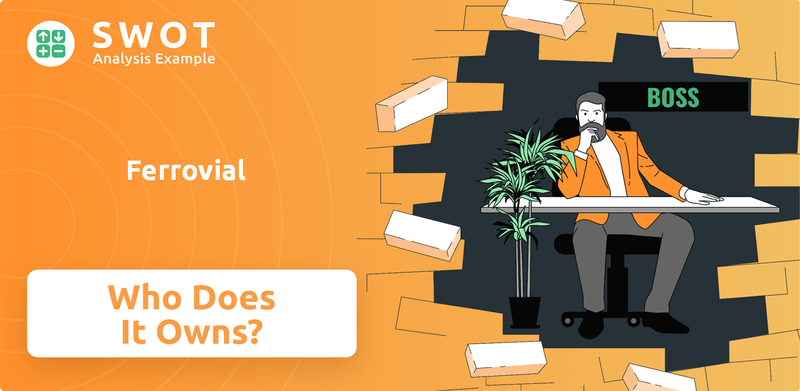
This deep dive into
Who Founded Ferrovial?
The Ferrovial company was established on December 18, 1952, in Madrid, Spain, by Rafael del Pino y Moreno. Initially, the company's focus was on railway construction, marking the beginning of its journey in the infrastructure sector. This early phase set the foundation for Ferrovial's future growth and diversification.
Rafael del Pino y Moreno's initial ownership stake in Ferrovial was 50%. The remaining shares were held by other members of his family. This ownership structure reflects the company's origins as a family-run enterprise, which has evolved over time while maintaining a significant presence in the infrastructure and services industries.
The founder's vision, as described by his son Fernando del Pino, emphasized initiative, creativity, and a commitment to service, quality, and reinvestment. This vision guided Ferrovial's early strategic decisions, including its expansion into international markets and diversification into various infrastructure projects.
Ferrovial's early years saw significant expansion and diversification. The company quickly moved beyond railway construction. By the 1960s, Ferrovial had broadened its scope to include road construction, waterworks, and buildings. This diversification was a key factor in its growth.
- In 1954, Ferrovial undertook a railway project in Venezuela, demonstrating its early international ambitions.
- The company entered the toll road concession business, notably with the Bilbao-Behobia Highway.
- In 1985, Ferrovial acquired Cadagua, an engineering and construction company specializing in water treatment plants.
Ferrovial SWOT Analysis
- Complete SWOT Breakdown
- Fully Customizable
- Editable in Excel & Word
- Professional Formatting
- Investor-Ready Format
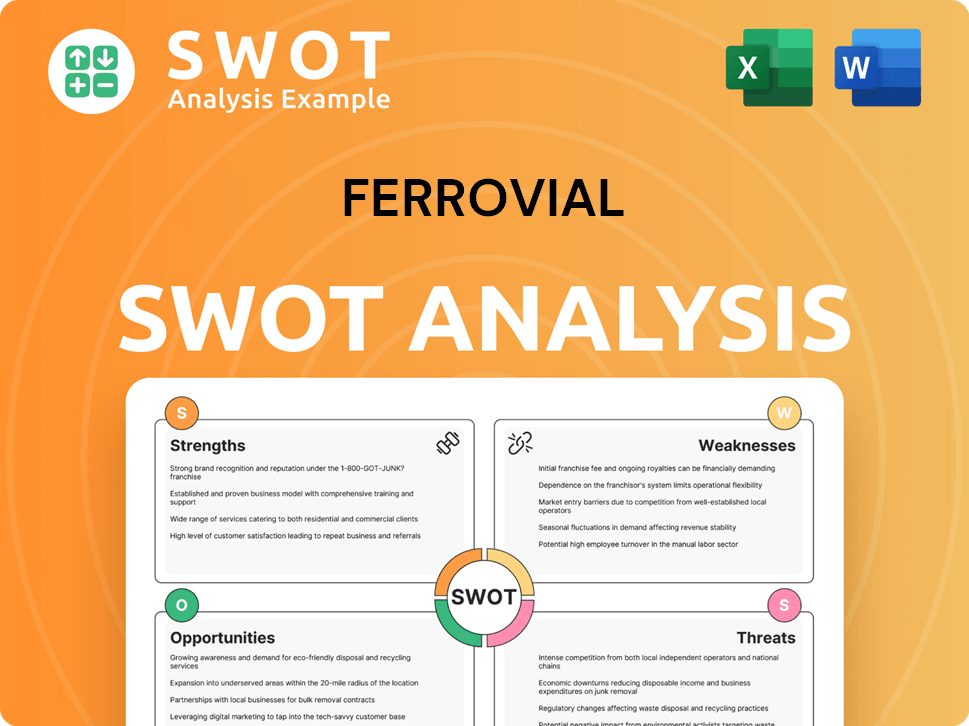
How Has Ferrovial’s Ownership Changed Over Time?
The Ferrovial company, a prominent player in infrastructure management, experienced a significant shift in its ownership structure since its initial public offering (IPO) in 1999. The IPO, which took place on the continuous market in Spain, involved the sale of approximately 35% of its shares, marking a significant event in Spanish financial history at the time. Despite this, the del Pino family retained majority control, holding over 57% of the outstanding shares immediately following the IPO, ensuring their continued influence over the company's direction.
Over the years, the ownership landscape of Ferrovial has evolved, with the del Pino family maintaining a substantial presence while also welcoming institutional investors. As of December 31, 2024, the del Pino family, through various entities, remained the major shareholders. Rafael del Pino Calvo-Sotelo, the current Chairman, held a controlling interest in Rijn Capital BV, which owned 21.5% of Ferrovial SE's shares. Other family members, such as María del Pino y Calvo-Sotelo, held significant stakes, reflecting the family's ongoing commitment to the company. Furthermore, institutional investors like HSBC Global Asset Management (UK) Limited, Amundi Asset Management SAS, and The Vanguard Group, Inc. held notable shares as of March 31, 2025.
| Shareholder | Stake (December 31, 2024) | Notes |
|---|---|---|
| Rijn Capital BV (Rafael del Pino) | 21.5% | Controlling interest |
| María del Pino y Calvo-Sotelo | 8.56% | Direct or indirect holdings |
| Leopoldo del Pino y Calvo-Sotelo | 4.28% | Through Siemprelara S.L.U. |
In August 2015, a notable change occurred when Portman Baela, the del Pino family's primary shareholder vehicle, sold its entire stake to its indirect shareholders. This led to individual family branches holding their shares directly. This strategic move resulted in Rafael del Pino controlling 20.10%, María del Pino 8.090%, Joaquín del Pino 2.524%, and Leopoldo del Pino 8.296% at that time. These adjustments showcase the family's strategic evolution in direct control and the increasing influence of institutional investors, impacting the overall Ferrovial ownership structure.
The del Pino family maintains significant control, with Rafael del Pino holding the largest individual stake.
- The IPO in 1999 saw the del Pino family retain majority control.
- Institutional investors hold notable shares as of March 31, 2025.
- The sale of Portman Baela's stake in 2015 led to direct family holdings.
- The ownership structure reflects a blend of family control and institutional investment.
Ferrovial PESTLE Analysis
- Covers All 6 PESTLE Categories
- No Research Needed – Save Hours of Work
- Built by Experts, Trusted by Consultants
- Instant Download, Ready to Use
- 100% Editable, Fully Customizable
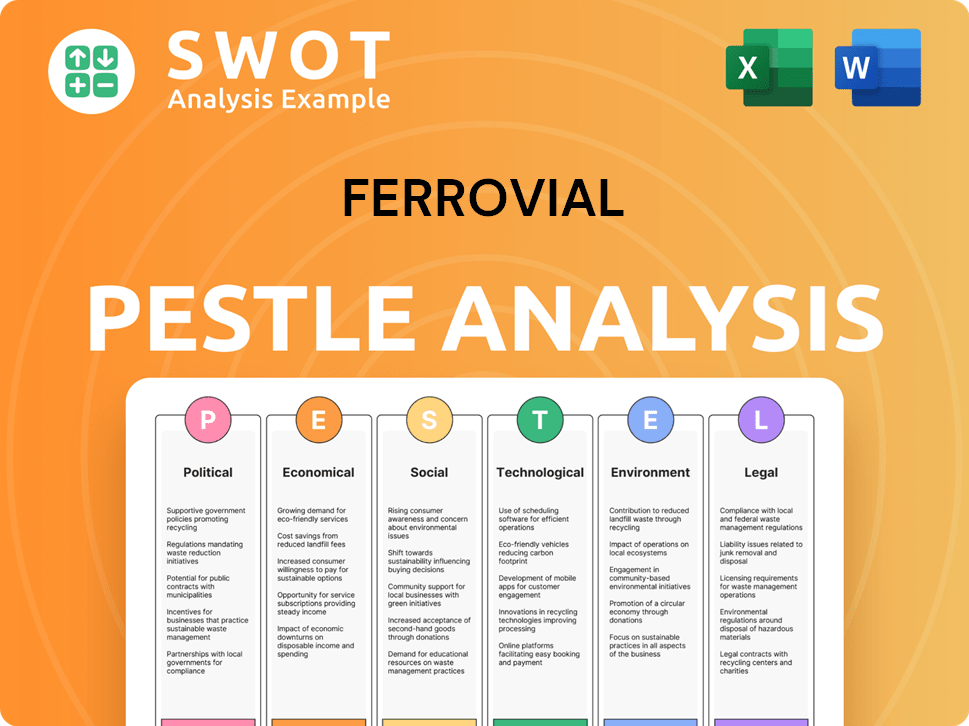
Who Sits on Ferrovial’s Board?
As of April 24, 2025, the board of directors of the Ferrovial company includes key figures. Rafael del Pino Calvo-Sotelo is the Chairman, holding a significant indirect stake. Other members include Óscar Fanjul as Vice-Chairman and María del Pino y Calvo-Sotelo, a major shareholder through Menosmares, S.L. Ignacio Madridejos serves as CEO.
The board also includes non-executive directors like José Fernando Sánchez-Junco, Bruno Di Leo, Hildegard Wortmann, and Alicia Reyes, all re-appointed at the April 2025 Shareholders Meeting. These individuals contribute to the company's governance, representing a mix of shareholder interests and independent oversight. The composition reflects the ownership structure and the strategic direction of the company, ensuring a balance of executive and non-executive roles.
| Director | Position | Shareholding |
|---|---|---|
| Rafael del Pino Calvo-Sotelo | Chairman | 21.32% (indirectly) |
| Óscar Fanjul | Vice-Chairman | Non-executive |
| María del Pino y Calvo-Sotelo | Non-executive Director | 8.56% (through Menosmares, S.L.) |
| Ignacio Madridejos | CEO | 0.02% (directly) |
The voting power within Ferrovial largely follows a one-share, one-vote system. However, the substantial holdings of the del Pino family, particularly Rafael del Pino, provide them with considerable influence. This concentrated ownership impacts decision-making processes. For more insights into the company's strategic approach, consider exploring the Marketing Strategy of Ferrovial.
Understanding Ferrovial's ownership structure is crucial for investors and stakeholders. The del Pino family holds significant sway, influencing corporate decisions.
- Rafael del Pino Calvo-Sotelo's role as Chairman and major shareholder is central.
- The board includes both executive and non-executive directors, ensuring diverse perspectives.
- Shareholder voting power is primarily based on a one-share, one-vote system.
- Changes in family shareholdings can lead to shifts in board representation.
Ferrovial Business Model Canvas
- Complete 9-Block Business Model Canvas
- Effortlessly Communicate Your Business Strategy
- Investor-Ready BMC Format
- 100% Editable and Customizable
- Clear and Structured Layout
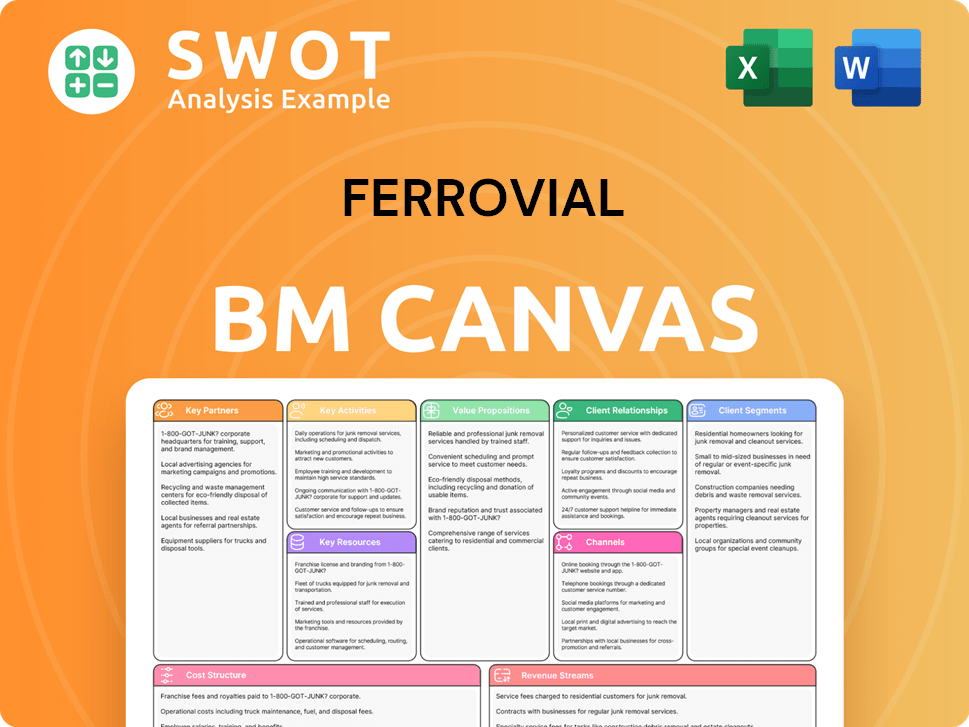
What Recent Changes Have Shaped Ferrovial’s Ownership Landscape?
Over the past few years, the Ferrovial company has undergone significant shifts in its ownership structure and strategic focus. A key development was the listing of shares on Nasdaq in May 2024, broadening its investor base and signaling a move towards internationalization. This dual listing strategy, alongside its presence on Euronext Amsterdam and the Spanish stock market, aims to increase accessibility for a wider range of investors. The company's commitment to shareholder value is evident through active share buyback programs and dividend distributions.
Share buyback programs have been a prominent feature. For example, a program that concluded on May 30, 2025, saw the acquisition of 13,470,000 shares, representing approximately 1.846% of the company's share capital, at a cost of €537,835,879.02. Another buyback program, authorized in August 2024, was for up to €300 million, targeting roughly 4.1% of the share capital. In 2024, Ferrovial shareholders received €831 million, including €271 million from share buybacks. For 2025, the company plans to distribute €570 million in dividends and buybacks, along with an additional share buyback program of up to €500 million. These actions highlight a dedication to returning capital to shareholders.
Strategic asset rotations also play a role in shaping the Ferrovial ownership landscape. Divestments include the sale of a 19.75% stake in Heathrow Airport for €2 billion in 2024 and a 5% stake in IRB Infrastructure Developers for €211 million. The sale of its 50% stake in AGS Airports, completed on January 28, 2025, for £450 million, generated a capital gain of €297 million in Q1 2025. Simultaneously, Ferrovial is making strategic investments, such as increasing its stake in the 407 ETR toll highway in Canada in June 2025, from 43.23% to 48.29% through a C$1.99 billion investment. These moves show a dynamic approach to portfolio management.
The company's shares began trading on Nasdaq in May 2024, expanding its investor base. Share buyback programs, including one that concluded on May 30, 2025, have been significant. Strategic asset rotations, such as the sale of stakes in Heathrow Airport and AGS Airports, are also notable.
In 2024, Ferrovial distributed €831 million to shareholders through dividends and buybacks. The company plans to distribute €570 million in 2025, plus an additional share buyback program of up to €500 million. These actions reflect a commitment to returning value to shareholders.
Ferrovial increased its ownership in the 407 ETR toll highway in Canada in June 2025. This investment, valued at C$1.99 billion, increased its stake from 43.23% to 48.29%. This highlights a focus on long-term infrastructure assets.
While Rafael del Pino remains Chairman, some family members have divested shares. The overall trend shows a focus on high-quality infrastructure and shareholder returns. The company adapts its ownership structure to a more global market.
Ferrovial Porter's Five Forces Analysis
- Covers All 5 Competitive Forces in Detail
- Structured for Consultants, Students, and Founders
- 100% Editable in Microsoft Word & Excel
- Instant Digital Download – Use Immediately
- Compatible with Mac & PC – Fully Unlocked
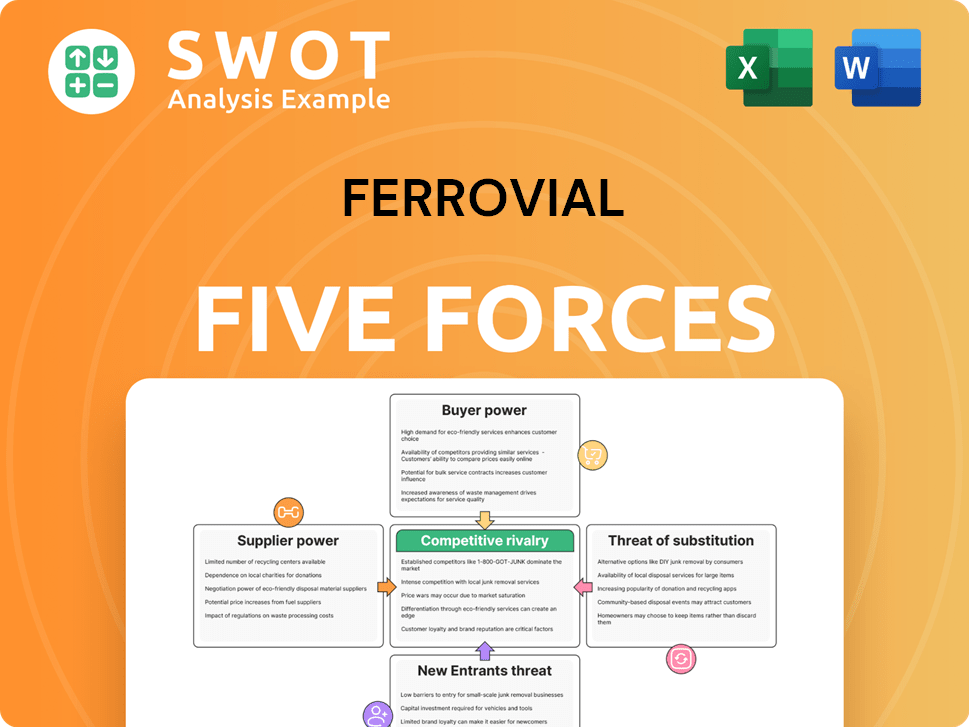
Related Blogs
- What are Mission Vision & Core Values of Ferrovial Company?
- What is Competitive Landscape of Ferrovial Company?
- What is Growth Strategy and Future Prospects of Ferrovial Company?
- How Does Ferrovial Company Work?
- What is Sales and Marketing Strategy of Ferrovial Company?
- What is Brief History of Ferrovial Company?
- What is Customer Demographics and Target Market of Ferrovial Company?
Disclaimer
All information, articles, and product details provided on this website are for general informational and educational purposes only. We do not claim any ownership over, nor do we intend to infringe upon, any trademarks, copyrights, logos, brand names, or other intellectual property mentioned or depicted on this site. Such intellectual property remains the property of its respective owners, and any references here are made solely for identification or informational purposes, without implying any affiliation, endorsement, or partnership.
We make no representations or warranties, express or implied, regarding the accuracy, completeness, or suitability of any content or products presented. Nothing on this website should be construed as legal, tax, investment, financial, medical, or other professional advice. In addition, no part of this site—including articles or product references—constitutes a solicitation, recommendation, endorsement, advertisement, or offer to buy or sell any securities, franchises, or other financial instruments, particularly in jurisdictions where such activity would be unlawful.
All content is of a general nature and may not address the specific circumstances of any individual or entity. It is not a substitute for professional advice or services. Any actions you take based on the information provided here are strictly at your own risk. You accept full responsibility for any decisions or outcomes arising from your use of this website and agree to release us from any liability in connection with your use of, or reliance upon, the content or products found herein.